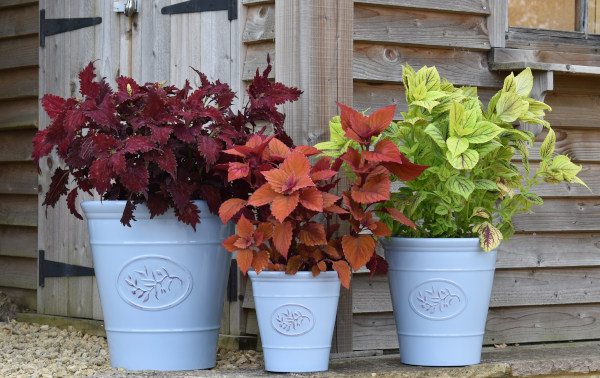How to grow Coleus (Solenostemon)
Also known as painted nettle, coleus is a tender evergreen perennial from tropical and subtropical forests in Asia and Africa. It is grown for its highly decorative, usually variegated foliage, with hundreds of differently coloured forms available and more introduced each year. Plants produce airy, delicate spikes of tiny, mint-like flowers during summer, though many gardeners remove these to direct more energy into the production of leaves.
Coleus is one of those plants on which seems to divide botanists. Over the years it has been grouped in with both solenostemon and plectranthus, and you may see it referred to as any one of these names in garden centres and nurseries, though we’ve decided to stick with the most widely used ‘coleus’. Whatever the name, it remains a firm favourite among UK gardeners, who value its season-long interest, easy-going nature, and versatility.
While non-toxic to humans, coleus can be poisonous to pets such as dogs and cats.
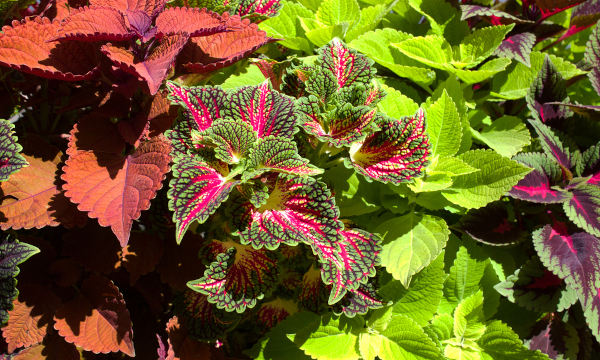
Zantedeschia is a genus of flowering plants from the family Araceae and is native to southern Africa. With a rich history dating back to the Ancient Romans, these deciduous or semi-evergreen perennials have been used as a symbol of celebration. Zantedeschia was Named after Professor Giovanni Zantedeschia, an Italian botanist.
There are two main forms of Zantedeschia: hardy and tender. Hardy forms of the plant can be grown outdoors, enjoy moist soil and full sun or partially shaded conditions - these are known as Arum lilies. Tender forms of Zantedeschia prefer being grown in containers or pots and should be brought inside over the winter - these are known as Calla lilies.
With tuberous flora in all colours from whites, yellows and oranges to deep reds and purples, Zantedeschias are not to be overlooked in any garden, as long as they have sufficient sunlight to grow in.
Ready to learn more about growing Zantedeschia? Read on for all there is to know...

Key Information
Soil pH
Position
Hardiness


Where & when to plant Coleus
Position - Sheltered from the wind, in full sun to partial shade depending on the variety. As a general rule, the older forms prefer shadier conditions, while many of the newer series, such as the ‘Copa’ range, have been bred to tolerate sun.
Soil - Any humus-rich, moist, well-draining soil
Flowering Period - Summer
Hardiness - Tender, rated H1C, i.e., minimum temperature of between 5°C and 10°C
Coleus hails from warmer climes than ours and can only live outside in the UK once all risk of frost has passed. This varies from region to region, though tends to be mid to late May. If your plants arrive before it is safe to go outdoors, keep them in a bright, frost-free environment until the time is right. A greenhouse, conservatory, coldframe, or sunny porch or windowsill are all ideal. Just make sure you don’t let them dry out! Small plug plants are best potted up into 9cm pots if they’re going to spend time in a ‘holding zone’ such as this.
Another important thing to note with tender plants like coleus is the need to gradually harden them off, rather than suddenly move them outside. This slow toughening up reduces the chances of them going into ‘shock’, which can severely check growth.
The easiest way to do this is by using a cold frame opened in gradual increments over the course of a week or two. Keep the lid closed at night until the last couple of days of the hardening off period.
If you don’t have a cold frame, a bit of horticultural fleece combined with a spot of ‘musical pots’ works just as well. A couple of weeks before you anticipate planting your coleus out, wrap the plants in a couple of layers of fleece and place outside during the day (moving back into a warm, protected environment at night). Do this for a few days then reduce the fleece to one layer. After a few more days like this, remove the fleece completely. If it’s warm enough you can leave outside at night too, though reapply the fleece for this. Towards the end of the hardening off period, leave your plants outside completely uncovered for a couple of days and nights before planting out as below.
When it comes to choosing a spot, coleus is ideal for a summer container display, hanging basket, or as a bedding plant in a border. Most UK gardeners treat coleus as an annual, though it can also be kept going for a few years as an evergreen houseplant. Keep it in a spot with bright yet indirect light, such as set back from the window slightly in a sunny room.
How to plant Coleus
- For planting in the garden, dig the soil area removing any large stones and weeds and breaking up any lumps. Mix in some organic matter such as manure or garden compost. Rake level and firm with your heels. Rake level again.
- Water plants well and allow to drain before planting.
- Dig a hole twice the size of the root-ball.
- Place the plant in the hole, ensuring the top of the root ball sits level with the surface of the soil. Too low and the plant may rot, too high and the roots can dry out.
- Backfill with soil and firm in gently with your foot.
- Soak well with water.
- Mulch around the base with well-rotted organic matter.
- For planting in containers, first choose an appropriately sized pot. You may wish to grow your coleus on its own in a pot, or as part of a larger, mixed container display. Either way, ensure there are plenty of drainage holes in the bottom.
- If you are using a large or heavy pot, it can be a good idea to fill and plant it in situ to save yourself the trouble of moving once full.
- Use a good quality potting compost with plenty of horticultural grit mixed in and, if not already present (check the labelling on the bag) some slow-release fertiliser granules.
- Start by partially filling the pot with compost; enough so that when placed on it the upper surface of the root ball is about 3cm lower than the top of the pot.
- Fill around the plant with compost, firming down with your fingers then adding a little more so it is held tight.
- Pick up the container (if you can!) and lightly tap on the potting bench or ground a few times to help further settle the compost around the plant.
- Soak well with water.
- A mulch with horticultural grit will look attractive and help to prevent a ‘cap’ or crust forming on the top of the compost (something container plants can suffer due to the artificial nature of their watering).
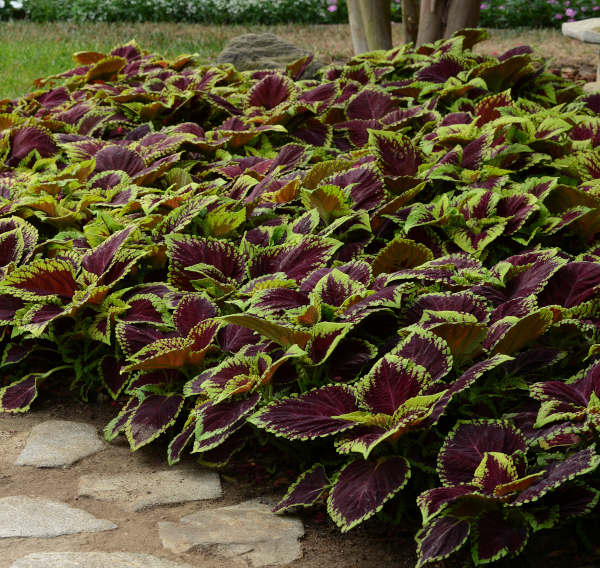
What to plant with Coleus
In a mixed container, coleus often takes the role of ‘thriller’, in combination with ‘fillers’ such as diascia and nemesia, and ‘spillers’ including aubrieta and Campanula poscharskyana.
Out in the garden, coleus is popular for adding texture and colour to the front of borders that have a ‘hot’ colour theme, along with other less hardy, temporary additions such as dahlias, cannas, cuphea, and small cordylines.
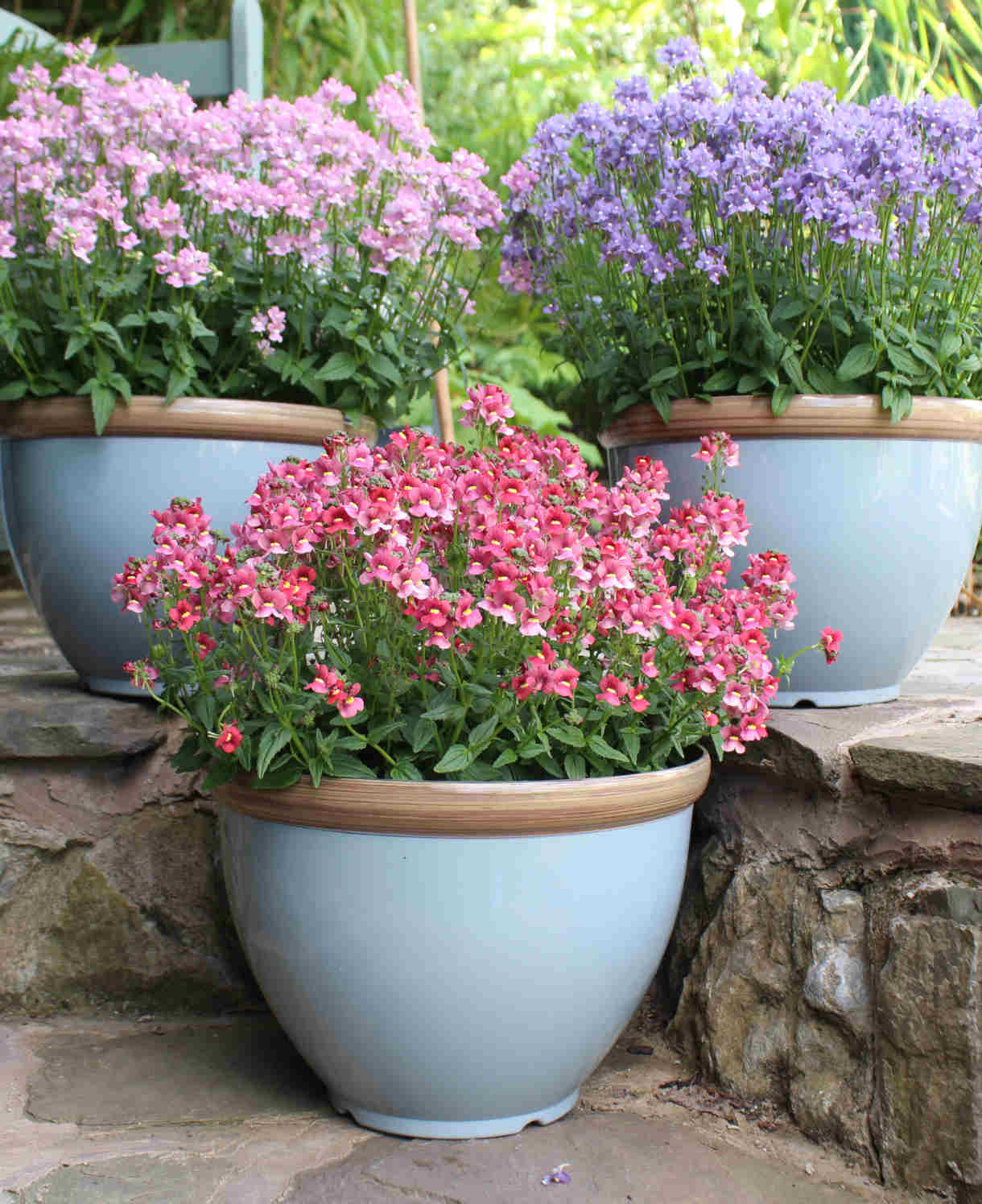
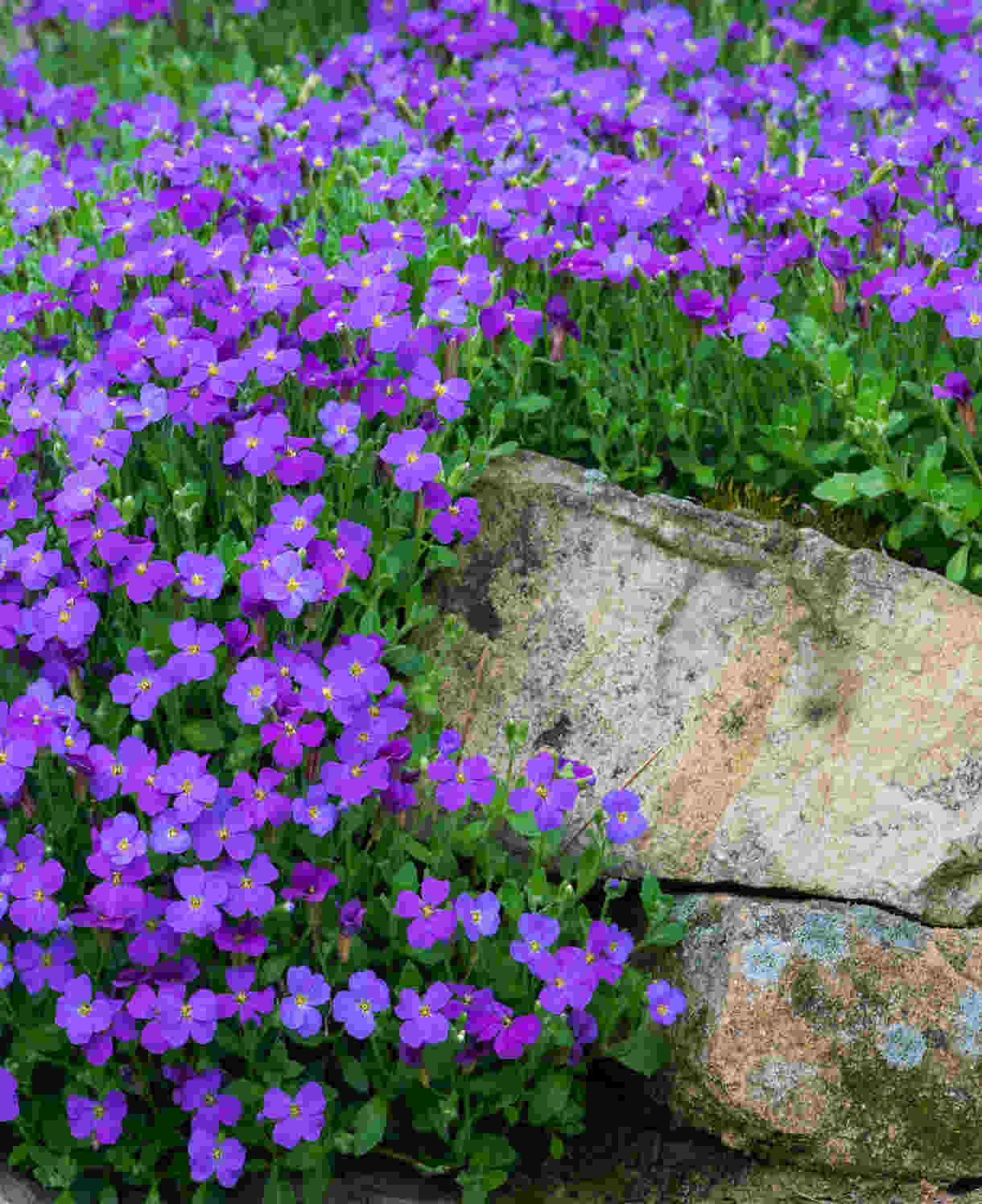
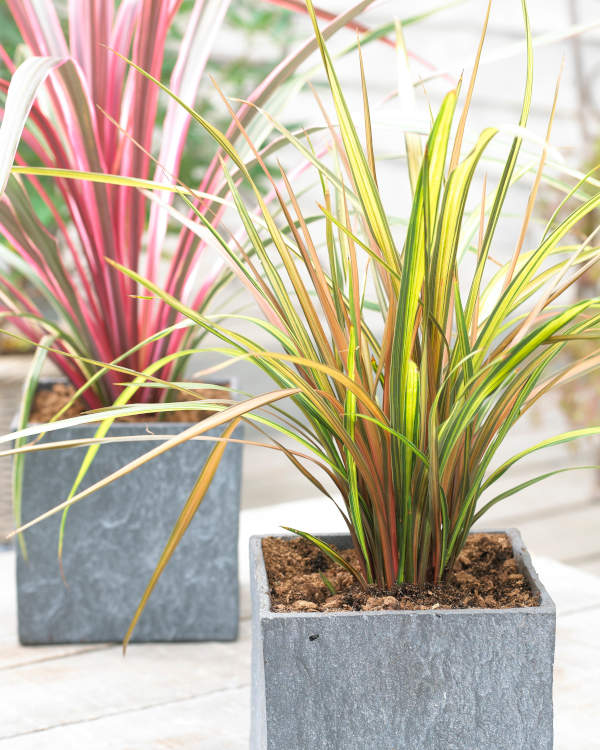
How to care for Coleus
Pruning and Deadheading
For a compact, bushy plant, regularly pinch out growing tips throughout spring and summer, nipping them off just above a lower pair of buds.
Flowers can either be left alone or removed as soon as they appear. The latter encourages the formation of more leaves.
If, like most gardeners, you intend to treat your coleus as an annual, simply remove it to the compost heap at the end of the growing season. To grow it as a houseplant, pinch back regularly throughout the growing season as described above, and remove any withered or damaged leaves in spring.
Watering
Coleus is a thirsty plant which can be watered freely during dry weather. Aim for consistently moist but not soggy soil/ compost.
A saucer placed under a container can be a great help in maintaining moisture in the compost, though even with this in place be aware that containers can need watering as often as once a day when conditions are hot (more if the container is very small or full). In the ground, a generous layer of mulch on planting is an effective way of locking water in the soil (see next section).
Feeding
To get the most out of hungry summer bedding plants such as coleus, regular feeding is a must – particularly when grown in containers.
In a container, coleus should be potted in a good quality compost with slow-release fertiliser granules mixed in. These generally provide enough nutrients for around 6 weeks, after which a liquid feed every 2 weeks can make a big difference to performance. Go for one high in nitrogen to encourage plenty of leafy growth.
In the open ground, mulch newly planted coleus with a decent layer of well-rotted organic matter, i.e., manure or garden compost applied to the soil around the plant. As well as boosting the nutrient content of the soil, this has the added benefit of suppressing weeds and locking in moisture. After this, you can either leave the plant to its own devices (fine on healthy, fertile soil), or apply a high nitrogen liquid feed as above (beneficial on poor or sandy soil).
Cold Protection
Coleus will not survive a UK winter outdoors. Either remove to the compost heap (having taken cuttings if you want to maintain your stocks – see propagation section below) or overwinter indoors as a houseplant, moving inside as temperatures begin to drop in early autumn.
Pests and Diseases
Outdoors, coleus tends to be problem free. Indoors, the usual issues of spider mite, mealybug and whitefly can crop up. Keeping houseplants as healthy as possible is the key to warding off problems, and by this we mean proper ventilation, adequately spaced plants (for good air flow), keeping everything well-watered and fed, and repotting into larger containers when necessary. Thoroughly cleaning the indoor environment every winter can also help to remove overwintering populations of pests.
Where infestations do take hold, try introducing biological controls (often sachets or tubes containing miniscule natural predators), or in the worst cases, remove the affected plant/s altogether.
How to propagate Coleus
Coleus is unlikely to come true from seed, and is therefore best propagated by softwood cuttings in spring or summer, with bottom heat:
- In the morning (plants are more turgid at this time and less likely to wilt during the process), take 10cm cuttings from the soft tips of new, non-flowering shoots. Snip off just above a bud using sharp, clean secateurs.
- Place in a clean plastic bag in which to transport the cuttings back to a potting bench or garden table.
- Fill a container with a well-draining compost mix.
- Trim the end of the cutting to just below a node (point at which leaves grow).
- Remove the lowest third of the leaves.
- Insert the cuttings into the compost and water lightly. Several cuttings can be put in the same container if there is enough space to do this without them touching.
- Place in a propagating unit with bottom heat if you have one, or covered with a plastic bag on a warm windowsill if not (out of direct sunlight). If using a plastic bag, remove it a couple of times a week for around ten minutes. This will ensure the cuttings remain well-ventilated and don’t rot.
- Keep the cuttings misted and occasionally watered until they root. You will know this has happened when roots emerge out of the bottom of the container.
- Gently remove rooted cuttings and pot them into individual pots. Grow on in a protected environment such as a conservatory, greenhouse, or that windowsill again, before planting out as above.
* Many plants carry Plant Breeders Rights and cannot be propagated for commercial purposes.
Common Coleus questions
How much sun does coleus need?
This really depends on the variety, some prefer shade, others can cope with a sunny spot. Check the individual description for details.
How long do coleus plants live for?
When treated as an annual, just one year. If kept in a warm environment, they may live for 3-4 years.
